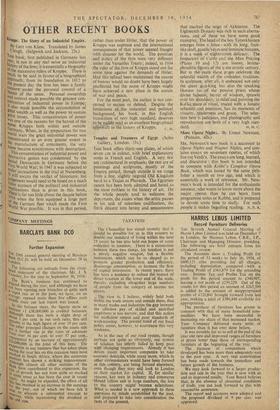Tins book offers thirty-one plates, of which seven are in
colour, with brief explanatory notes in French and English. A very few are zrchitectural in emphasis; the rest are of paintings and sculptures, mostly of the Empire period, though outside it we range from a tine, slightly negroid Old Kingdom herd to a Trajan as Pharaoh. The Egyptian canon has been both admired and hated as the most ruthless in the history of art. On the whole people tend to welcome the departures, the asides when the artist pauses in his task of relentless codification, the freak descent into heresy and sensuousness
that marked the reign of Akhnaton. The Eighteenth Dynasty was rich in such aberra- tions, and of these we have some good examples. The head of the boy Tutankhamen emerges from a lotus—with its long, fruit- like skull. gazelle's es es and feminine features, it is a work of nightmarish delicacy. The • Inspectors of Cattle and the Man Praying (Plates 10 and 12) are lissom, herma- phroditic figures of the s:ine erratic centuiy. But in the main these plges celebrate the splendid wealth of the orthodox tradition. In sculpture, after all, it embraced not only • the giant god-king but also the speaking likeness (as of the pensive Priest whose divine baboon, bearer of wisdom, sprawls over his shoulder); in relief and painting the • Kafka maze of ritual, traced with a lunatic . urbanity and precision, has its moments of vivacity, tenderness and grace. The selec- tion here is judicious, and photography and reproduction are both of a very high stan-








































 Previous page
Previous page